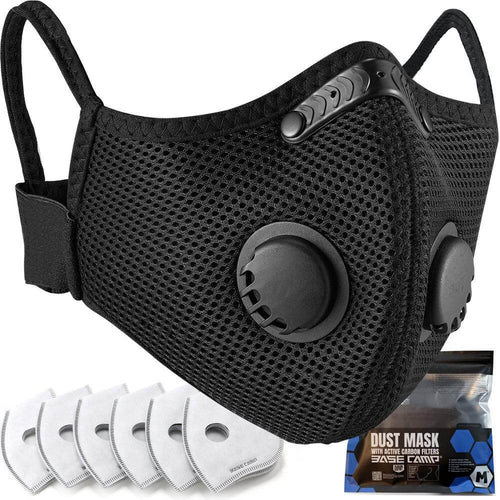Woodworking is a rewarding hobby and profession that allows individuals to create beautiful pieces of furniture, art, and more. However, it also exposes craftsmen to wood dust, which can be harmful when inhaled over time. To protect your respiratory health, choosing the right wood dust mask is essential. This guide aims to provide you with all the information you need to select the most suitable mask for your woodworking needs.
Understanding the Risks of Wood Dust
Wood dust is a byproduct of woodworking activities such as sawing, sanding, and shaping wood. It consists of tiny particles that can easily become airborne and enter your respiratory system. Prolonged exposure to wood dust can lead to various health issues, including:
- Respiratory Irritation: Wood dust can irritate the respiratory tract, causing symptoms such as coughing, sneezing, and shortness of breath.
- Allergic Reactions: Some wood species contain allergens that can trigger allergic reactions in susceptible individuals.
- Chronic Health Problems: Long-term exposure to wood dust has been linked to serious health conditions such as asthma, bronchitis, and even lung cancer.
Given these risks, wearing a proper wood dust mask is crucial for anyone engaged in woodworking activities, whether as a hobbyist or a professional.
Types of Wood Dust Masks
When it comes to choosing a wood dust mask, there are several types available, each offering different levels of protection and comfort. The most common types include:
- Disposable Dust Masks:
- These masks are affordable and designed for single-use purposes.
- They are lightweight and provide basic protection against large particles.
- Ideal for occasional woodworking tasks with minimal dust exposure.
- Respirators with Replaceable Filters:
- These respirators offer more advanced protection than disposable masks.
- They feature replaceable filters that can capture smaller particles and provide better filtration efficiency.
- Suitable for regular woodworking activities where moderate to high dust levels are present.
- Powered Air-Purifying Respirators (PAPRs):
- PAPRs use a battery-powered fan to draw air through a filter, providing constant airflow and enhanced protection.
- They offer the highest level of protection against wood dust particles.
- Recommended for professional woodworkers or those working with highly toxic wood species.
Key Considerations When Choosing a Wood Dust Mask
Selecting the right wood dust mask involves considering several factors to ensure optimal protection and comfort:
- Filtration Efficiency:
- Check the mask’s filtration efficiency, which is indicated by its NIOSH (National Institute for Occupational Safety and Health) rating.
- Masks with higher NIOSH ratings (such as N95 or N99) offer better protection against finer particles.
- Fit and Seal:
- A proper fit is essential to prevent leakage around the mask edges.
- Look for masks with adjustable nose clips and straps for a secure and comfortable fit.
- Comfort:
- Choose a mask that is lightweight and breathable, especially if you will be wearing it for extended periods.
- Consider features like exhalation valves to reduce heat buildup and moisture inside the mask.
- Durability:
- Depending on your woodworking frequency, choose a mask that can withstand regular use and maintain its effectiveness over time.
- Replace filters or cartridges as recommended by the manufacturer to ensure continued protection.
- Compatibility with Safety Glasses and Hearing Protection:
- Ensure the mask you choose does not interfere with the proper fit of safety glasses or hearing protection devices.
- Some masks are designed to integrate seamlessly with other safety gear for maximum comfort and protection.
Choosing Based on Wood Species
Different wood species produce varying levels of dust and potential allergens. Consider the following when selecting a wood dust mask:
- Softwoods (e.g., pine, cedar):
- Generally produce larger wood dust particles.
- A basic disposable mask may suffice for occasional tasks.
- Hardwoods (e.g., oak, maple, walnut):
- Tend to produce finer dust particles that can be more hazardous.
- Opt for a respirator with higher filtration efficiency and better seal.
- Exotic or Treated Woods:
- Some exotic woods or treated lumber contain toxic substances or allergens.
- Use a PAPR or respirator with specialized filters for maximum protection.
Maintaining Your Wood Dust Mask
Proper maintenance of your wood dust mask is crucial to ensure its effectiveness and longevity:
- Cleaning:
- Follow the manufacturer’s instructions for cleaning and disinfecting your mask.
- Regularly wipe down the exterior and replace filters or cartridges as recommended.
- Storage:
- Store your mask in a clean, dry place away from contaminants when not in use.
- Protect it from direct sunlight and extreme temperatures to prevent degradation.
- Replacement:
- Replace disposable masks after each use or when they become visibly soiled or damaged.
- Replace filters or cartridges according to the manufacturer’s guidelines to maintain filtration efficiency.
Conclusion
Choosing the right wood dust mask is essential for protecting your respiratory health during woodworking activities. Whether you are a hobbyist or a professional woodworker, selecting a mask that offers adequate filtration efficiency, a comfortable fit, and durability is key. Consider the type of wood you work with, the level of dust exposure, and your specific comfort preferences when making your decision. By prioritizing safety and investing in a quality wood dust mask, you can enjoy woodworking while minimizing the risks associated with wood dust inhalation.
